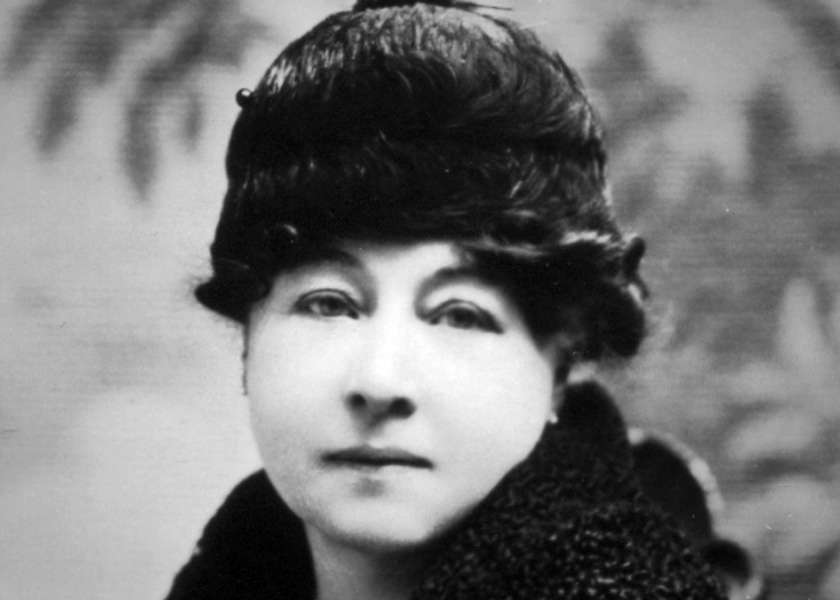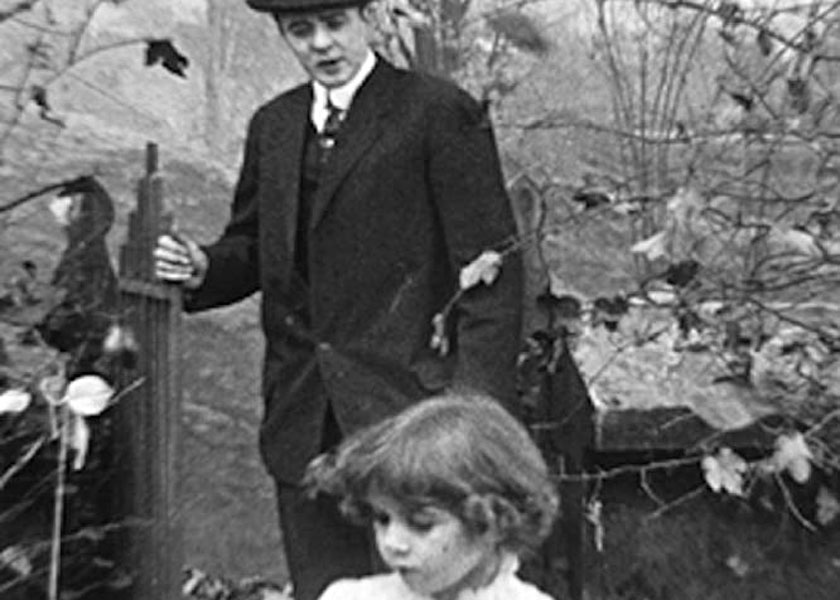Synopsis
In his medical offices, Dr. Earl Headley (Greenleaf) presents to his fellow physicians several patients who have been cured of consumpion by his newly developed serum. His associates congratulate him.
In the Thompson home, older daughter Winifred (Swayne), is very ill. She in unable to read or sing to her little sister Trixie (Foy). Fainting, coughing, and holding her painful chest, Winifred is taken to bed by her mother (Cornwall) and the maid. Trixie is left alone, sad, and wondering what she can do to help her sister.
Frightened, Mrs Thompson calls the family doctor. He listens to Winifred’s chest as she coughs. He kindly pats her arm and reassures her. Unseen by Winifred, he gives Mrs Thompson a discouraging look.
In the living room, the doctor gestures out the window toward the autumn leaves
dropping from the trees and tells Mrs Thompson the truth,
When the last leaf falls, she will have past away.
He repeats this sad
prediction to Mr Thompson. Trixie, standing inconspicuously in the back of the
room, is listening intently.
After her parents go to Winifred’s bedside, Trixie looks out the window at the falling leaves and shakes her head. She has taken the doctor’s words literally. She mouths the words and moves her arms to point out the falling leaves and makes gestures indicating that she intends to tie them to the branches.
That night, Trixie leaves her bed, puts on her shoes, gets a ball of string, and
goes into the garden. She picks up fallen leaves and ties them to the branches.
Dr. Headley, passing by, sees her and asks what she is doing.
I am tying these leaves to keep my sister from dying.
She describes
Winifred’s illness to him.
Dr. Headley tell her that he can treat Winifred, and Trixie takes him into the house. He introduces himself to her mother, who is searching for Trixie, and tells her about the serum and his hope to save Winifred. He exams Winifred and administers his serum. He tells Mrs Thompson that her daughter should recover.
Three months later, Winifred is recovering rapidly. Dr Headley visits, bringing her flowers. He sits down with Winifred and reveals an affection for her. Quietly, Trixie and her parents leave them alone.
Discussion
Public exhibition of moving pictures began in the 1890s. The earliest films were very short, often lasting a minute or less, and were generally composed of a single image of people or objects in motion. Production of films that told a story began around 1900, and movie-going quickly became very popular with the public. By 1908, thousands of small theaters, known as nickelodeons, had opened in towns and cities throughout America. The program at the nickelodeon lasted about an hour and usually consisted of one or two short narrative films and a few even shorter documentary subjects, such as landscapes and scenes of everyday life. Each theater presented several different programs per week. About twenty motion picture companies, mostly located in the New York area, produced the large number of films required to support this system. For efficiency across the industry, the length of one film was standardized as a single reel of one-thousand feet of film with a running time of fifteen minutes.

Among the production companies making one-reel films was Solax Films, founded by film pioneer Alice Guy-Blaché in 1910, the first woman film director. Alice Guy's career began in 1896 for the French manufacturing company Gaumont Chronophone. In France she directed, produced and supervised hundreds of short (running one to seven minutes) silent films and another 150 synchronized sound films. In 1907, Alice married Herbert Blaché, another employee of Gaumont, and accompanied him to New York where Herbert was sent to manage the American subsidiary of the Gaumont Studio. In 1910, Alice Guy-Blaché started her own production company, Solax Films. At first, she made her films at the Gaumont Studio in Flushing, New York. In 1912, she opened her own Solax Studio in Fort Lee, New Jersey. Solax released one or two one-reel films a week. Alice wrote and directed at least half of these films and supervised the rest.
Domestic difficulties predominated as the plot lines of the Solax films. Alice wrote the scenarios for many of her films. If she was not the only writer for Falling Leaves, she probably was fully involved in preparing the scenario.
Movie studios advertised their products in trade magazines that featured stories
of interest to members of the film industy. Ads for Solax Films, which
predominantly featured domestic difficulties as plot lines, were prominent in
trade publications. The weekly magazines published manufacturer’s synopses of
their newly released films. In March 1912, Moving Picture World, an
important trade publication, printed informational notes from Solax Films about
its latest release, Falling Leaves. The notes stress the expected
emotional responses of the audience to the film:
the pathos of the production worms a way to the heart — gently touches
the heart strings
as the innocent belief tying up leaves will save her sister,
and
gentler emotions of gentle and emotional people going through a crisis are
visualized on screen with convincing realism.
Guy-Blaché, who wrote the scenarios for many of her films, is the credited
author of a one-page story adaptation of Falling Leaves printed in
the April 12 issue of Motion Picture News.
The story of how Trixie’s innocent belief
that tying up the leaves will
save her sister actually brings about her cure is told realistically and with a
minimum of emotionalism. By 1912, camera consciousness
had declined in film
acting. Actors had reduced the practice of looking directly at the camera and
using exaggerated facial expressions and hand and arm gestures as a means of
conveying feelings and ideas. In this production, the acting is fairly natural,
with a minimum of excessive gesturing. An exception is the actor playing the
family doctor who dramatically points out the window toward the trees at each
death prediction. Magda Foy, playing Trixie, talks at the camera while she
explains her thoughts aided by elaborate gestures, but she was only seven years
old. Mace Greenleaf’s acting is particularly restrained.
The main set is the family parlor, with a large picture window opening into the garden, visible outside. The camera is locked-down, sitting stationary on a tripod, looking into this room; the action takes place between the walls (always visible) of the room, with an omniscient point of view, as in a play. The figures are seen from the mid-leg up. The camera moves to a closer view of the garden when Trixie is tying up the leaves. Since the child is short, she is seen from the waist and disappears from view as she bends down to pick up a leaf. For a moment, the camera looks into the empty space until she stands up again. Although there was no technical reason the camera position could not be changed to show the child as she bent down, there was no need to change it either.
Assembly line production of one-reelers required speed to turn out between one to three films weekly. Filmmakers, including Guy-Blaché, lacked an impetus to experiment and expand film language to start breaking up scenes into a variety of different shots. More camera setups meant more time filming and more time editing, increasing costs and slowing the rate of output for the studio.
Since much of the adult population attended the nickelodeons frequently, a theater operator had to change the film program equally frequently, either every day or every other day. The turnover rate had two effects on film production: a large number of films were necessary to meet the demand and the quality of individual pictures was generally de-emphasized. The audience, still satisfied with filmed plays, came so frequently and watched so many films that their quality had little effect on box office returns to theater owner or production company.
Advancing film language required progressive filmmakers like D.W. Griffith.
Probably, Griffith and his crew became so adept at producing one-reelers they
could afford to start experimenting a bit. As feature-length films arrived, fewer
films taking longer to make with more complex plotting evolved, allowing the
advancement of montage, greater film language, and breaking up of scenes.
Constructing a scene using a variety of camera set-ups (master shot, medium shots,
closeups, inserts, etc.), often referred to as breaking up the scene,
has
been an elementary part of film language for decades, but was a technique
virtually unknown during the one-reel story film days.
Falling Leaves takes some liberties with medical reality. In 1912, tuberculosis, or consumption as it was known, was not curable by any chemical compound. The disease is caused by an infective organism, the bacterium Mycobacterium tuberculosis. A compound (streptomycin) effective against the bacteria was not discovered until 1943.
Autumn is the time of change, the ending of the bounties of spring and summer. In
literature, the falling of the leaves has long been utilized to signify change and
endings. In a 1907 short story called The Last Leaf by O. Henry, an
ill young woman is certain she will die when the last leaf outside her window
falls. An artist paints a permanent leaf on the window. She lives, but he comes
down with pneumonia as a result of his exposure while painting the leaf and dies.
In May 1912, Gaumont Films released The Shade of Autumn. In this
film, Little Bobby hears the doctor tell his father that mother will die with the
last falling leaves. The child rushes out and begins to pick up leaves as fast as
he can. Bobby soon despairs because he is unable to pick them all up. He runs back
home and finds that his mother has died. Falling Leaves and
Shade of Autumn are two examples of melodramatic
falling leaves
stories, and it would be surprising if many other versions
could not be found among the many one-reel films produced in the earliest days of
cinema.
The uncredited cast of Falling Leaves features the principal actors of the Solax Company. Magda Foy (1905-2000), billed as the Solax Kid, starred in 26 films for the company between 1910 and 1913. She left films when Solax converted from one-reelers to features. Blanche Cornwall (1868-1918) appeared in 64 Solax one-reelers. Her film career also ended at the conversion to features. Marion Swayne (1891-1973), who was with Solax for four years, had notable roles in several domestic comedies. Her career continued until 1924. After six films for Solax, Mace Greenleaf (1872-1912) moved to the Lubin Manufactering Company. He had made only one film for that company when he contracted pneumonia and died. Darwin Karr (1875-1945), who wears a wig to age his appearance, was in 140 films between 1911 and 1922, all but three of them one- or two-reelers. After leaving Solax in 1913, he was with Vitagraph, then Essanay, and finished his film career with a film each with Mary Pickford and Richard Dix.
The age of one reelers lasted until 1913, when multiple-reel films, called features, rose in popularity and replaced the one-reeler. As features became the new standard for the industry, theater owners discontinued their programs of short films. The small companies that had made one-reelers either merged or ceased operation. After 1913, Guy-Blaché moved into feature film production and soon changed the name of her production company, eliminating Solax Films.
Further Reading

